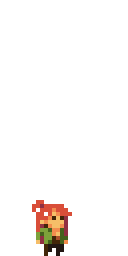The type of pixel sprites that I'll be doing for the game are relatively big, and the level of detail is high in comparison to initial pixel art where characters could have a 24x24 sprite (like the old megaman games) to a more detailed 150 pixel sprite.
I've documented the initial part of the process of the creation of the sprites of one of the elements that I like the most: the fountain of the Harpy.
The idea started as a sketch where I added some watercolour, but this was just to give me an idea (and play with watercolours for a bit). I scanned it and modify the background, mainly just to make it easy to work with.
Then I made it semi transparent and using the pencil tool and preferences that will help me to keep hard edges in case of any movement or modification. I start with a very loose line, mainly just following the contour, as if I was to redo the line work.
After all that is finished then I can turn off the reference and go into detail to fix the line. The image below is the outcome of a quick line.
The image below is the how it looks after cleaning up, the idea is to avoid having any overlapping pixels. This will give an effect from further as a clean curvy line. This could be one of the processes that take the longer as is a matter of individually erasing and painting pixels all over the line. At the same time, you need to be zooming in and out to make sure the line is taking the shape desired, as is very easy to get it to look wonky...and in fact sometimes is just hard to correct and can only be corrected once the rest of the solid colour is along.
This is the difference between the quick first line and the final clean up. This 'rule' wont apply everywhere as the hand that's suppose to be closer I decided to make its line thicker mainly to use a comic like technique of line weight.
After that I started blocking out colour and shadows, which roughly follows the idea of cellshading with hard edges on the change of each colour/ shadow, this is mainly to give a sharp contrast and help the perception of the shape. In this case the statue is some sort of plaster material with its own shadows, while it will be cover with mould due to the dampness. Eventually I'll add the water falling down. This process is not finished as the shading requires just as much work as the line work. Also the main line will have colour and will nicely blend along with the rest of the colours. This kind of big landmarks on the level need to be very detailed, in comparison to the rest of the props, so I'll keep posting some of the further finished props as I go.





















